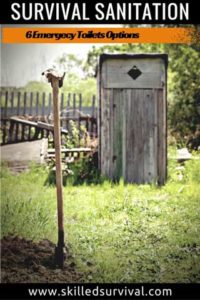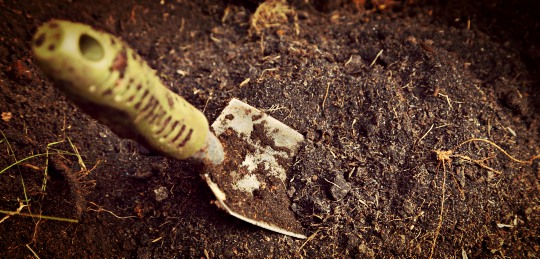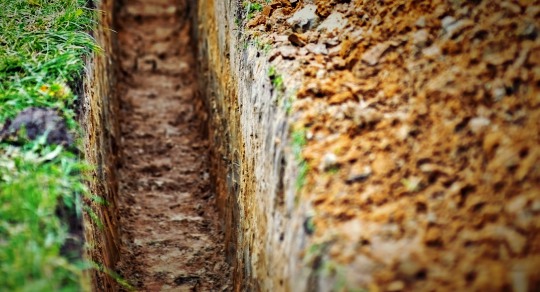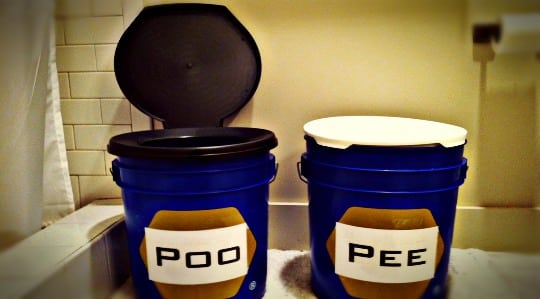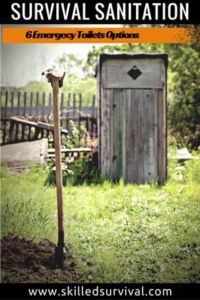
Every animal does it.
As humans, we’re just more ingenious at containing it, handling it, and hiding it.
Bears, for instance, crap in the woods.
Most people, on the other hand, use toilets.
And over the course of history, by God, we have become attached to our porcelain thrones. Because they are:
- Efficient
- They keep life clean
- They’re comfortable
- They’re familiar
Imagine what life would be like without our modern-day toilets.
Unfortunately, in a long-term survival situation, you may get to find out. Because when your toilet won’t flush, you’ll be up sh*t creek without a paddle.
However, there are always alternatives. Greener pastures, so to speak.
With a little bit of elbow grease and some age-old techniques, anyone can make a makeshift waste reciprocal. No, it’s not the most glamorous bit of survival knowledge, but damn, if it isn’t one of the most important ones!
Because there are severe consequences for mismanaging human waste.
Of course, you can’t just start defecating when/wherever you like. We aren’t senseless creatures. There are protocols for these sorts of things, rules for safety, and measures to prevent severe consequences.
Because listen: nobody wants to use a cat-hole “toilet” for months on end (if you don’t know what that is, we’ll get to it later). And more than that, it can be bad for your health, the health of others, and the health of your local environment.
So if you want to truly get prepared, this How-To article is for you.
Human waste is easy to joke about, but it can cause some deadly problems if it isn’t addressed seriously in a survival situation. Waste management has been around since the advent of humans. And it will still be around long after the “shit hits the fan”. If you understand how to deal with it in a safe, clean, and efficient way, you will have a big leg up on your survival competition.
(Besides, if you are an avid hunter, backpacker, rock climber, camper, or outdoorsman of any kind, understanding how to manage waste in the outdoors is absolutely essential).
How to dispose of human waste (poop and pee) after a disaster
Are You Ready For The Tough Times Ahead? Take My 60 Sec Quiz To See If You’re Part Of ‘The Fragile Masses’ Or Not… Start Quiz Now!
A Brief History of Toilets
A brief history of toilets video
Waaaaaay back in the day, during the time of ancient Romans, toilets were kept on the outside. No privacy stalls, no flushing mechanisms, and no cell phones to satisfy your boredom.
Just stone toilet seats on the street that dropped waste into underground cesspits or street drainage systems.
Needless to say, this was not sanitary. This form of waste management resulted in lots of health problems for the residents of ancient Rome.
In medieval times, a similar concept was adopted to accommodate castles and large cities. It consisted of a toilet seat over a deep hole, where waste was deposited, and forgotten about forever.
There was no flushing mechanism (unless it was positioned above flowing water, in which case all the unsanitary contents contaminated the local water source).
How did the Romans go to the toilet?
Chamber pots were also popular throughout history and are still widely used in hospitals and other care centers. The biggest drawback to these, though, is that they have to be emptied after each use. And cleaning a chamber pot is not fun.
In rural, off-grid locations the outhouse has always been a standard solution, but it was not until the late 1800s that the flush toilets we currently use today became the norm. And thank god for that!
History must have stunk like a public port-a-john on a 120-degree day.
The WHY – Dangers of Un-Managed Waste
Unless you like infectious diseases, you need to stay on top of waste management. In survival; infectious diseases are bad news. I am talking about nasty characters like cholera, dysentery, rotavirus, norovirus, hepatitis A and E, cryptosporidium parasites, and a host of worms. Bad shit (pun intended).
Fecal sanitation issues kill people. And wouldn’t it suck to die because you were not careful with your poop? Or worse yet, to watch your family or community suffer and die around you from fecal-related illnesses?
The dangers are so serious and so real, that developed nations have laws surrounding your waste. No matter where you are, or what you are doing – if there is not a working toilet available, you need to be careful how and where you deposit your load.
Besides, in the simplest terms possible: it sucks to live around a bunch of exposed, decomposing crap. That’s just a fact.
In survival, if you don’t plan a system to manage your waste, your home, and surrounding areas will become your toilet and you end up living in a dirty bathroom. And nobody wants that.
The 6 Best Emergency Toilet Solutions
Fortunately, there are several methods for dealing with your waste. Here are the most popular, most effective emergency toilet solutions:
 Image Source
Image Source
1. Catholes
We will start with the quickest, simplest emergency toilet option to build. It is the least comfortable, least sustainable option for an emergency toilet, but it works…in a pinch.
The cat hole is simply small a hole dug roughly 6 inches deep using a shovel. You squat over the hole and do your business. When you are finished, fill it, pat it down, and forget about it. FOREVER.
Everyone should be prepared to utilize this option in the great outdoors and for short-term survival situations.
Here are the best survival shovels worth an investment and a video on how to do this right.
How to Poop in the Woods
However, the problem with cat holes is that in large quantities they’re terrible for the environment.
Plus, who wants to dig holes and squat outside for an extended period of time? The answer is; No One. If you’re staying put in one location, cat holes are not your best option.
Catholes are best on the move or camping for short periods of time deep in the backcountry. Not for communities or families living in one place.
2. The “Poop Tube”
This option is most popular amongst hikers, backpackers, and especially rock climbers because it is lightweight, easily packable, and even reusable!
While there are a few online companies that offer “poop tubes”, it’s better to just go to your local hardware store and gather the makings for yourself.
Simply get a length of PVC pipe (the length of width is entirely up to you – most people prefer a tube ~1’ in length and 4-5” in diameter, but preference varies significantly from person to person) and a couple of caps for both ends.
By this same logic, you can use plastic bags or other airtight, lightweight containers for waste containment and transportation. But once again: this is not an option you can live off of long-term.
After several weeks you will tire of your poop tube and will start to look for more sophisticated long-term emergency toilet solutions.
Poop Tube 101
 Image Source
Image Source
3. The Latrine Trench
A latrine is like a larger, slightly higher-tech version of the cat hole.
By digging a ~4 ft. deep x 6 ft. long trench you can create a makeshift bathroom trough. And with a few sturdy branches and some cordage, you can build a basic A-frame structure.
This simple lean-to makes for a rustic seat so users can position their butts directly over the target zone.
Once a latrine reaches capacity, you cover it with a significant amount of dirt and another location must be found for a new latrine trench.
You can utilize the latrine trench on a longer-term basis. Much longer than using cat holes or poop tubes, but they are still considered a “temporary” means of waste management.
How to Dig a Latrine for a Large Group
As A Way To Introduce You To Skilled Survival, We’re Giving Away Our #78 Item Complete Prepper Checklist. Click Here To Get Your FREE Copy Of It.
4. Outhouses
The outhouse is a more complicated option and takes more planning, time, and effort to put together than latrine trenches. Most of us have used an outhouse (and if you haven’t, get out there and try it – that is a fundamental human experience), so you know what the general premise is.
Essentially, dig a really deep, wide hole, build a privacy shed with a seat, and place it over the hole. Voilà!
Outhouses are a tried and true way to manage a significant amount of waste, and while they still require a decent amount of work, they are relatively labor-free (once built) compared to some of these other options. They also do a better job of containing the unpleasant odor of human waste.
Building an Outhouse at the Off Grid Cabin
Of course, even a large outhouse pit will eventually fill up. And when it fills up you have two courses of action you can choose from:
- Either fill the hole up with dirt and move your privacy shelter to a new place and start over.
- Or if you have access to the right technology/equipment, you can empty outhouses every so often, eliminating the need to move the bathroom at all.
Filling and moving are the traditional way of doing things, but, like cat holes and latrine trenches, it’s hard on your surrounding environment.
One way to extend the life of your outhouse is to avoid peeing in it. Save your crapper shed for number 2 uses only. Urine equals excess weight and volume that you can dispose of in the woods.
Quick Story…
When I recently spent time in the Arctic Circle in Alaska (specifically at Camp Kavik) the outhouse had a sign that read: “Real Men Piss In The Bushes”.
Of course, this isn’t only true, it also made sure that unnecessary wastes weren’t added to the outhouse storage containers. The more people that peed in those outhouses, the faster the outhouse storage systems filled up, and the more often Kavik Sue and her entourage had to empty them.
And for the ladies, you can get a female urination device that makes it much easier to pee in the bushes just like the gents.
 Image Source
Image Source
5. The Poop Bucket & Survival Toilets
A portable camping toilet is as simple as it sounds. When you’re done, just take the bucket to your designated waste dumping area (could be an outhouse or latrine trench) and dump it away.
This is basically a DIY chamber pot.
How To Make The Business Bucket
Some people recommend lining the bucket with a plastic bag, so there’s less cleanup to do in the aftermath and it’s easier to transport. This works, but it also means you have to dump plastic bags into the environment, which pollutes the area and takes thousands of years to decompose.
This, at first will not be an issue, but after a few weeks (or months) in one place, it will build up into a mountainous non-degradable problem that does not just go away with time.
There are several upgrade options to a poo bucket, but the general idea is very similar: it provides a comfortable place to sit, relax, and crap, while also offering a container to keep waste away from things you care about.
Many come with insertable linings for disposal, but you can always add your own (plastic shopping bags from grocery stores make a great alternative, but anything plastic is detrimental to the environment – I suggest you use biodegradable poop bags. They are cheap, easy to use, and save the Earth a bit).
Here are a few of the best survival toilets available online:
If you want the simplest lightweight toilet solution, then consider Biffy Bag Disposable Toilets. They are ideal for anyone who plans to move on foot. And is perfect for people who have a bug out vehicle, a survival trailer, a survival RV, or even a remote bug out location.
Exclusive Bonus Content – Skilled Survival’s 104 Item Bug Out Bag Checklist – the only bug out checklist worth using. Click Here To Get Your FREE Copy Of It.
Another portable survival toilet option is this pop-up portable toilet.
The Camco 41541 Portable Toilet is another excellent option for those who want a more robust emergency toilet option.
The Century Portable Toilet is another option for anyone with room in the vehicle. It is thick plastic, durable, and easy to maintain.
However, the biggest downside to all these bucket and container emergency toilet options is: what do you do with the poo once the containers fill up?
You can’t just put it in a pile and pretend it’s not going to become a health hazard. So next up is my favorite emergency toilet solution for survivalists and off-grid locations.
6. Composting Toilets
If your survival plan includes staying at a specific location (your home or bug out location) then you must invest in a composting toilet. They are an ingenious solution to the “no tap water” equals “no flushing” problem.
Plus, they turn your waste streams into fertilizer for your survival garden.
These toilets look like traditional flush toilets but instead of flushing the waste away, it collects it and helps to accelerate the breakdown of the waste into fertilizer.
How to Make Humanure Composting with a Composting Toilet
Nature’s Head is a leader in composting toilet space. While it’s a bit of an investment to get one, it should be a major piece of every serious survivalist’s waste plan.
Plus, it’s perfect for off-grid homes and it’s perfect for reducing your water bill today, and it’s a “must-own” for your preparedness strategy.
Here’s a video of how these emergency toilets work.
Nature’s Head Composting Toilet – Honest Review
 Image Source
Image Source
But What About Toilet Paper?
Everyone understands the plight of a toilet paper deficit. The panic that sets in, after you’ve done your business and realize that there is no toilet paper, no tissue, not even a paper towel. That’s the stuff of nightmares.
So do your best to prepare for this. Always keep a roll or two in your bug out bag or outdoor backpack, you will thank yourself – trust me.
The same goes for any other method of waste management – outhouses, latrine trenches, cat holes, etc. – to keep toilet paper and tissues stocked up.
It’s relatively cheap and may become a great bargaining tool after SHTF.
So if you don’t want to ever imagine running out of T.P. – it’s wise to keep a large stockpile.
As A Way To Introduce You To Skilled Survival, We’re Giving Away Our #78 Item Complete Prepper Checklist. Click Here To Get Your FREE Copy Of It.
But what happens if we all run out?
Nowadays, a mass supply shortage of T.P. is not a situation we think about often. But you should think about your T.P. plan B. And some of you probably already know what plan B is: plants.
That’s right! Should you run out of toilet paper in the wilderness, hunkering down, or in a bug-out situation; you are going to have to resort to a natural solution. And plants are your best bet.
BUT BE CAREFUL!
Wiping your ass with poison ivy will make life worse. Pinecones work (but be sure to wipe with the grain of the cone… NOT against it). Or there’s Mullein weed, wooly lambs ear, and other soft leaf-like plants that also work fairly well.
You may be surprised.
In the Midwest, corn cobs are an option to get the job done, but things are going to get pretty sore fast. Our modern-day butts have been pampered by copious amounts of soft tissue paper.
Being forced to switch to leaves and corn cobs is going to be a literal pain in the ass. So be mentally prepared for that!
The Final Word
There is a reason we never see characters in movie scenes using bathrooms or movies about how ancient cultures dealt with their waste: people do not like to think about piss and shit.
That is all well and fine, but when there are no government-run programs, or agencies to manage our waste, and there’s no running water to flush our toilets, someone is going to have to step up and put together a plan for dealing with the problem.
Whoever that person is, no matter what community, or what group they belong to, they will be heralded as a hero.
Toilets aren’t glamorous. But most of us use one every single day. It’s just part of life as a human that will never go away, and the consequence of ignoring it is serious.
Don’t fall victim to your own feces.
Will Brendza
P.s. Are you ready for the tough times ahead?
Find out now by taking my short Readiness Score Quiz – it’s absolutely free.
Once complete, you’ll know exactly where you stand on the “fragile” vs.” resilient” spectrum.
So click here to start the Quiz….And don’t worry; the questions are so easy a 3rd grader could answer them.
Click on the image to begin the Quiz and find out once and for all if you’re part of “The Fragile Masses” or “The Resilient Few.”
The post Best Emergency Toilets To Manage Waste In A Pinch appeared first on Skilled Survival.


